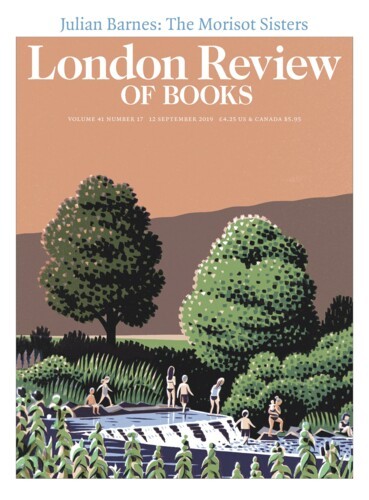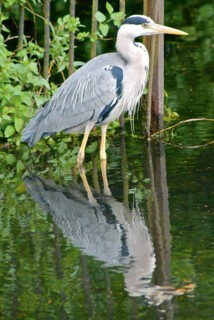Swimming in the wild or nearly wild has grown unrelentingly in popularity over the last ten years, and no one can deny that it feels wonderful: if not at the time, then certainly afterwards. For Londoners the locus of the activity is Hampstead Heath, with its three ponds: women’s, men’s and mixed. There are cold water lidos at Brockwell and Hillingdon and Tooting Bec, as well as just down the hill from the Heath at Gospel Oak, and there is the park pool of the Serpentine, with its abundant birdlife and passing rollerbladers. But nowhere else offers the peculiar charm of the Heath, the sense of not being in London at all. What was long the pastime of a seasoned few has become the shared pleasure of the many. On hot days, as in recent weeks, only the earliest arrivals can hope to gain admittance; crash barriers and guards manage the optimistic queues of hundreds.
Though only three are allotted to swimmers, the Heath contains or borders some thirty ponds. The largest, dotted down each side of a map – the Highgate side on the east and the Hampstead side on the west – were dug as reservoirs in the 18th century, when the Heath and its environs were still outside London, but close enough to provide fresh water. They are fed by the springs of the River Fleet, London’s greatest subterranean stream. The Ladies’ Pond, which is now the subject of At the Pond, a collection of confessional essays published by Daunt (£9.99), opened in 1925. The ponds had been used for bathing since their creation – it really is more bathing than swimming – but the designation, by the Greater London Council, regularised their use. The meadow that runs around two sides of the Ladies’ Pond is surrounded by trees, planted to keep out prying eyes; the pond itself is small, and smaller in winter when the furthest depths are closed off. This is no American pond kilometres wide, but a ‘hole’, as the New Yorker put it, around ninety metres by fifty. Still, for pool swimmers, the lack of lanes and shallows makes it a small sea. Once you have left the ladder, there is nowhere to rest, unless you cling for a moment to a buoy or life-ring, attached to ropes at the edges and the middle of the pond.
The darkness of the water, the coldness of the water and the greenness of the scene are the pond’s appeal. The water is slick – many of the Daunt contributors call it ‘silky’ – with a fine mud: ‘I split into the deep.’ ‘I slipped into the black.’ Skin beneath it takes on a sickly pallor. In summer, the contrast between water and air – or rather, between water and body – isn’t always stark enough to provide the shock to the system that regular visitors crave. It is a virtuous hit but a real one, and this must be why so many of the authors in At the Pond take their problems to the pond. ‘Your brain is lurched out of any spiralling,’ Lou Stoppard writes, ‘forced to only focus on the cold.’ Their depressions, abortions, divorces, ageing pains and existential angst – their practicality and humour – will not surprise anyone who has eavesdropped while swimming there. Although the gate sign says sharply ‘Men not allowed beyond this point,’ men are often the most common subject of conversation (though perhaps we shouldn’t let them know). One afternoon: three teenage girls laughing at a boy’s photo on a phone; two old German women discussing a philanderer they know – ‘He’s a real charmer, a belly charmer’ – and two young women struggling to hold on to a life-ring while debating the validity of a drunken marriage proposal. ‘Does it count? I don’t even want it but I want to know if it counts.’
Most swimmers come for silence. The Daunt writers describe giving themselves over to something, a kind of sacrifice (Esther Freud: ‘I arrived, fragile and fearful’). In the cold, the heart and lungs slow down, blood vessels contract, and the mind grows pleasurably dull. Unlike the other two swimming ponds, the Ladies’ Pond is completely secluded – a true enclosure – which comes with certain freedoms and complications. It’s hard to reach by most transport routes and hard to find unless you know it’s there. Inside, you can relax, you can take off your top (but not your knickers), you can feel unobserved. The communal showers have a glass panel, which surprised me as most women there shower in the nude, until I realised that the glass was to allow those inside to look out over the bucolic scene: how nice not to need protecting from people looking in. Except that, of course, the arboreal border does exactly that (it’s curious how many male runners find they need to stretch by the one gap in the trees). Providing this form of sanctuary necessarily places limits on desire. Eli Goldstone writes about finding one sunbather incredibly sexy: ‘Instead of trying to draw her attention, I packed my book into my bag and left. I felt that my desire towards her was urgent and intrusive.’
Goldstone’s is the most feral contribution to the Daunt book, and her pond is a place of breaking out as well as turning inward. In Pondlife (2013), his book about swimming at the Men’s Pond, Al Alvarez takes a more lively, even jubilant attitude towards his dips, less emotional strife – though the gradual curtailment of his visits becomes an index of ageing – more bird-watching and male camaraderie. There must be a good deal of cruising at the Men’s Pond, but he doesn’t touch on that. The height of rebellion at the Ladies’ Pond is to break in after dark – night swimming, by candlelight, was once permitted – and in her piece the lifeguard Nell Frizzell reports on the preponderance of underwear discovered after balmy evenings. As for the birds, the ponds are fully occupied by them, peeing as they go, and citydwellers, women and men alike, fall into rhapsodies over coots and Canada geese. Both ponds are watched over by a heron (it’s not clear if it’s the same heron). Alvarez finds Hardy in him: ‘He stretched his neck and flapped his wings and flew away … “with a great bold noise as of opening doors and shutters”.’ The women tend to be more prosaic: ‘It’s a dodo!’ cried some youthful swimmers recently. ‘It’s a pelican!’ I have been chastised by a hardened ponder for admiring the heron's swoop. ‘He’s beautiful,’ I said. ‘Not if you’re a fish,’ she replied.
There is more life to the ponds than birds. Most swimmers don’t wear goggles and don’t care to see what’s busying itself beneath them. Frizzell, from the lifeguard’s perch, can see the fish and mussels, the water snakes and slow worms. A seven-foot reticulated python, freed by an overambitious owner, infamously made the Ladies’ Pond its final home and was only discovered on its death in 2013. Everything under the surface is benign, it seems, though that doesn’t make it any less disconcerting to brush against a clump or lump of something. Stoppard calls swimming in the pond ‘stirring cream’. I know what she means, but I prefer Forster’s ‘swimming in salad’. There isn’t much of the splashing and chasing of A Room with a View’s bathing scene, but the pond’s fauna and flora make it extremely conducive to the literary associations of the glade and painterly associations of lake and river. Dolly Alderton – not in the collection – likes to think she is ‘in a particularly elegant scene of a D.H. Lawrence novel’. So Mayer – in the collection – sees the Ladies’ Pond as rescuing the Heath from Keats and other Great Romantic Males, though it’s those men I often find myself thinking of there, or Marvell’s proto-Romantic ‘happy garden-state’, except that in this case it’s woman who walks blissfully without a mate. Shorn of its life-rings, the Ladies’ Pond could easily be a place where shepherds are lured to their deaths or heartbroken maidens go to dunk and deluge themselves, or escape from predatory hands by turning into nymphs or water lilies or salmon. You, too, can play the Lady of Shalott. Pond etiquette circumscribes photography – this isn’t a place to be Instagrammed, except covertly – but its recent popularity reflects its cultural cachet, both as wellness chic (improve your immunity!) and as a pillar of urban middle-class naturalness: the fetishised domesticity of kombucha-makers and pinafore-wearers gently satirised by the (sadly defunct) Twitter account @BougieLitWoman.
Going to the pond is so out of the ordinary for most people that it’s not surprising it becomes a performance for some, a solemn ritual for others. Sophie Mackintosh, whose strange and slippery novel The Water Cure imagines – among other things – the punishments that water can inflict, writes here about ‘forgiveness’ and ‘permission’. Perhaps the Ladies’ Pond would seem less special in Berlin, with its eighty lakes, where swimmers venture unpoliced and unprotected. The ponds at the Heath are interrupted by modernity and municipality. There are buoyancy aids, changing rooms and toilets, the lifeguards’ decks and yellow canoes. There is also a gentle paternalism, growing stricter as the weather changes (‘Warning: water is cold and deep’). After October, casual dippers are dissuaded. You must swim at least twice a week to acclimatise to the low temperatures. The conviviality of the winter swimmers is attractive: the Daunt contributors share tips on using body heat to dispel hypothermia, staying in for no longer in minutes than the water temperature in centigrade, investing in neoprene socks and gloves (to wear a wetsuit would betray the pond’s Freikörperkultur), being wary that the cold comes on strongest after you’ve left the water. If the shared suffering of the hundred-odd women who swim come hail or sleet makes them a little proprietorial (and more than a little evangelical), it’s understandable. They haven’t enjoyed the media attention. Shouting about the ponds isn’t in the spirit of the ponds, but it has led to a greater and more varied body of swimmers. And the ponds are regularly tested, which given the levels of pesticides and toxic metals in most rivers is some cause for wild swimmer comfort. We have never been very good at self-regulating our water pollution. The Fleet, once a great thoroughfare, leaves the Heath to become a sewer, and is put to use quietly washing our waste out of the city. In Pope’s day, when it still ran above ground, it was so filthy that he described schoolchildren diving in ‘where Fleet-ditch with disemboguing streams/Rolls the large tribute of dead dogs to Thames’.
Send Letters To:
The Editor
London Review of Books,
28 Little Russell Street
London, WC1A 2HN
letters@lrb.co.uk
Please include name, address, and a telephone number.


